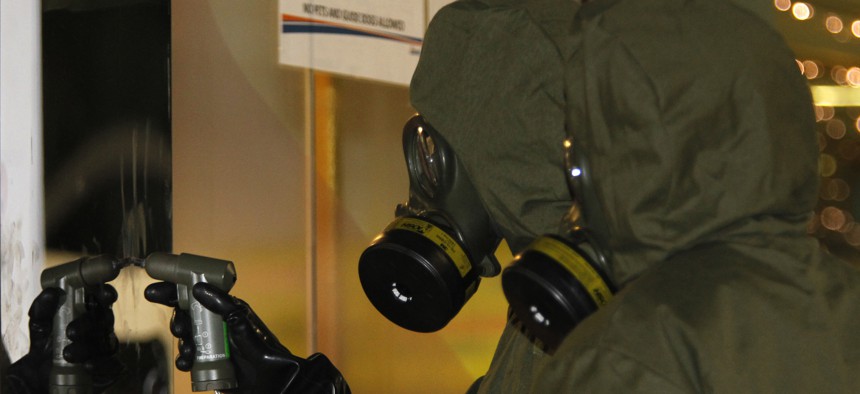
A Hazmat crew checks a stain on the wall at Kuala Lumpur International Airport 2 in Sepang, Malaysia on Sunday, Feb. 26, 2017. AP / Daniel Chan
DHS Aims to Replace Slow, Outdated Bioterror-Detection System
A new plan to draw on big data and distributed sensors will replace a 2003 system that can take up to 39 hours to detect a threat.
In order to fight next-generation biological threats, the Department of Homeland Security, or DHS, is revamping the way the government collects, uses, monitors and distributes information. The hope is to get something that works far faster than the system in use today to catch a pandemic before it starts.
Biological weapons detection “is and has been a problem,” DHS Assistant Secretary James F. McDonnell, who leads the Countering Weapons of Mass Destruction Office, said at a September event sponsored by Noblis.
It’s harder, for example, than finding stolen or illicit nuclear weapons. The latter is a binary problem; radioactive material is present in sufficient quantity to trigger the alarm, or it isn’t. But detecting biological threats is more difficult. Variabilities in particulate matter, weather, and other natural conditions can all affect readings to great degree.
“What the air looks like in Washington during the Cherry Blossom Festival is a lot different than what the air looks like on a cold, rainy afternoon. The air in Denver is different from the air in California,” said McDonnell. “There are so many different variables when you are trying to understand particulates in the air.”
While emergency workers and authorities can quickly ascertain what sort of damage has been done by a bomb, biological contamination can spread a long way before it is detected.
Today, DHS sniffs for bioterrorism in 30 U.S. cities under the BioWatch program, which gathers air samples over 24 hours, sends them to a lab, and uses polymerase chain reaction analysis to look for DNA from toxins or pathogens.
McDonnell says the 15-year-old BioWatch program has become inadequate — in particular, it’s too slow.
“It’s 11 to 13 hours after [the sample] is taken to the laboratory before a decision is made” as to whether a biological agent has been deployed, he said. “That gives you up to 39 hours in between samples and the decision. If you take Penn Station in New York, with 600,000 people a day going through it and a 9-million-person subway system… and our current [concept of operation] is which would let you know, ‘Yesterday, someone released smallpox,’ you have a global pandemic before we’re done doing the analysis.”
McDonnell says that while the department will continue to use BioWatch, they will also move toward replacing it with a new monitoring system. The new system that will add sensors — including ones on government cellphones — and make better use of the ones scattered across a list of government agencies that includes Customs and Border Patrol and the Transportation Securities Administration. They’ll also work to better integrate all that data in a way that lets everyone see what everyone else is doing.
Most importantly, DHS wants the new system to constantly scan the environment for subtle irregularities that could point to the presence of a biological agent, rather than just sniffing for the agents themselves. To prevent false positives, the system will use big-data analytics to determine whether an anomaly warrants human inspection.
“What we are doing is deploying real-time triggers that will do bio-sensing and identify anomalies. To determine that anomaly is going to be difficult. It’s going to take some time and some advanced analytics to figure out the bell curve for what’s normal in what time of day. There is quite a bit of data. That’s going to be a big project for us. But the [concept of operations] looks similar to the nuclear [detection] concept of operations at the end of the day,” McDonnell said.
When such an anomaly is detected, ”smeone with a handheld kit will go down and do an assessment to see if it’s positive for anthrax or not. Now you’ve gone from ‘we had smallpox released yesterday’ to, in 20 or 30 minutes, doing incident management.”
McDonnell’s job was created in December, in what a DHS press release called “one of the most significant reorganizations of the Department in a decade.” The House recently voted to make the office permanent. McDonnell was appointed to head the office in May.




